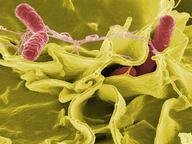Quiz Answer Key and Fun Facts
1. Anthrax is a bacterial disease spread by spores which are commonly found where?
2. Bacillus anthracis is the name of the bacterium which causes anthrax. What does bacillus mean?
3. There are three main types of anthrax infection. Which of them is the most common?
4. A vaccine against anthrax was developed as long ago as the late nineteenth century by which scientist?
5. Woolsorters' disease is another name for anthrax.
6. What is the main symptom of cutaneous (skin) anthrax?
7. Which type of anthrax has the worst prognosis, especially if treatment is not started soon after infection?
8. Which domestic animals are least likely to be affected by anthrax?
9. An outbreak of anthrax in Scotland during late 2009 and 2010 was caused when which of these was contaminated with the bacteria?
10. During World War II scientists investigated the use of anthrax for biological warfare leaving Gruinard Island severely contaminated. Where is this island located?
Source: Author
rossian
This quiz was reviewed by FunTrivia editor
WesleyCrusher before going online.
Any errors found in FunTrivia content are routinely corrected through our feedback system.
